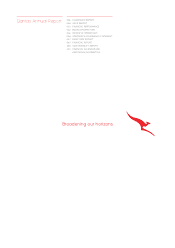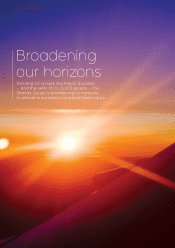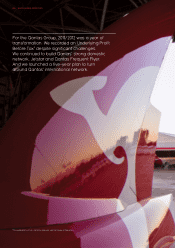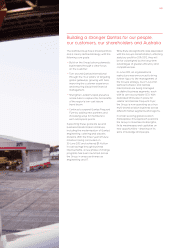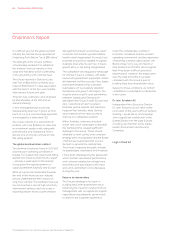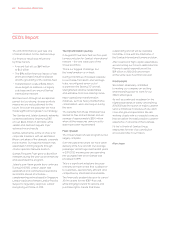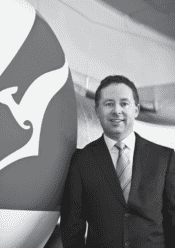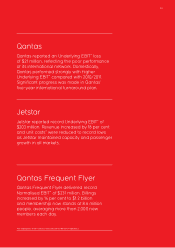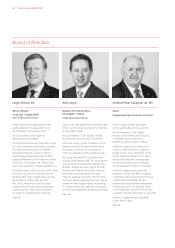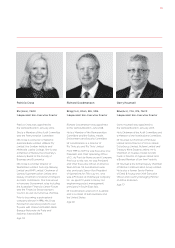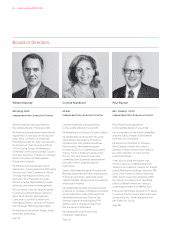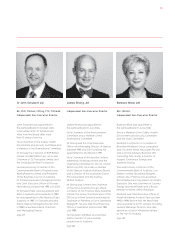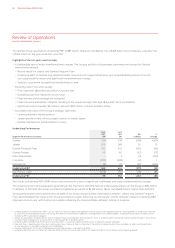Qantas 2012 Annual Report Download - page 10
Download and view the complete annual report
Please find page 10 of the 2012 Qantas annual report below. You can navigate through the pages in the report by either clicking on the pages listed below, or by using the keyword search tool below to find specific information within the annual report.
CEO’s Report
The 2011/2012 financial year was one
of transformation for the Qantas Group.
Our financial result was influenced
by three factors:
— A record fuel bill, up $645 million
to $4.3 billion
— The $194 million financial impact of last
year’s prolonged industrial dispute
and the grounding of the Qantas fleet
— Transformation costs of $376 million,
as we began to address our legacy
cost base and turn around Qantas’
international network
We have been through an exceptional
period, but our strong, diverse portfolio
means we are well positioned for the
future. And over the past year we have
made significant progress in our strategy.
The Qantas and Jetstar domestic networks
combined delivered Underlying EBIT
of over $600 million in 2011/2012, while
Jetstar and Qantas Frequent Flyer
achieved record results.
Qantas remains the airline of choice for
corporate travellers, with an estimated
84 per cent share of the domestic corporate
travel market. Our regional network has
expanded in mining regions through
charter operator Network Aviation.
Qantas Frequent Flyer grew to 8.6 million
members during the year as we enhanced
and expanded the program.
Jetstar’s pan-Asian growth story continues.
During 2011/2012, Jetstar Japan was
established and commenced operations
six months ahead of schedule –
complementing airlines based in Singapore
(Jetstar Asia) and Vietnam (Jetstar Pacific).
Subject to regulatory approval, Jetstar
Hong Kong will follow in 2013.
The transformation journey
In August 2011 we launched our five-year
turnaround plan for Qantas’ international
network – the one weak part of the
Group’s portfolio.
This is our biggest challenge, but
the transformation is on track.
During 2011/2012 we increased capacity
to our Dallas/Fort Worth and Santiago
hubs, reconfigured seven out of
a planned nine Boeing 747 aircraft,
strengthened alliance relationships
and withdrew from loss-making routes.
Major operational transformation
initiatives, such as heavy maintenance
consolidation, were also begun during
the year.
The benefits from these initiatives have
started to flow and will deliver annual
savings of approximately $300 million
when all the measures announced to
date have been implemented.
Fleet renewal
The Group’s fleet renewal program is now
largely complete.
Over the past three years we have taken
delivery of 114 new aircraft. Our average
passenger aircraft age reached 8.3 years
in 2011/2012, meaning we are operating
the youngest fleet since Qantas was
privatised in 1995.
This is a significant milestone because
it means we have a fleet that is attractive
to customers, operationally efficient and
competitive by international standards.
The financially prudent decision to cancel
35 firm orders for the B787-9 aircraft,
while bringing forward 50 options and
purchase rights, means that these
outstanding aircraft will be available
from 2016, in line with the timeframe of
the Qantas International turnaround plan.
After a period of high capital expenditure,
we are turning our focus to debt reduction.
Planned capital expenditure will be
$1.9 billion in 2012/2013 and remain
at the same level next financial year.
Great people
We remain absolutely committed
to making our company an exciting
and rewarding place to work for our
33,600 employees.
As well as continued investment in the
highest standards of safety and training,
2011/2012 saw the launch of major customer
service initiatives in areas such as cabin
crew and ground operations. We are
working closely with our people to ensure
that we deliver the best possible customer
experience in all parts of the business.
I’d like to thank all Qantas Group
employees for their vital contribution
at a pivotal time in our history.
Alan Joyce
QANTAS ANNUAL REPORT 2012008



